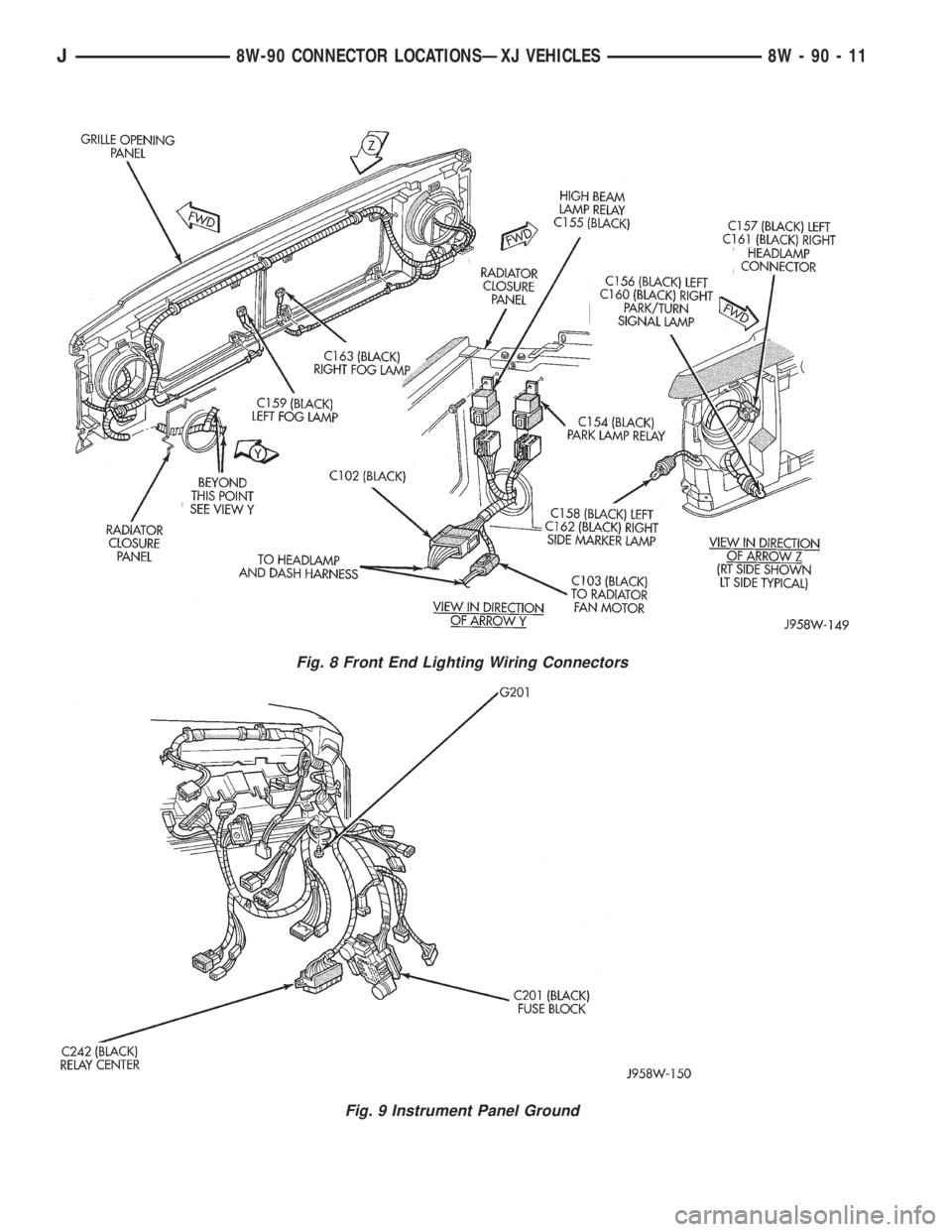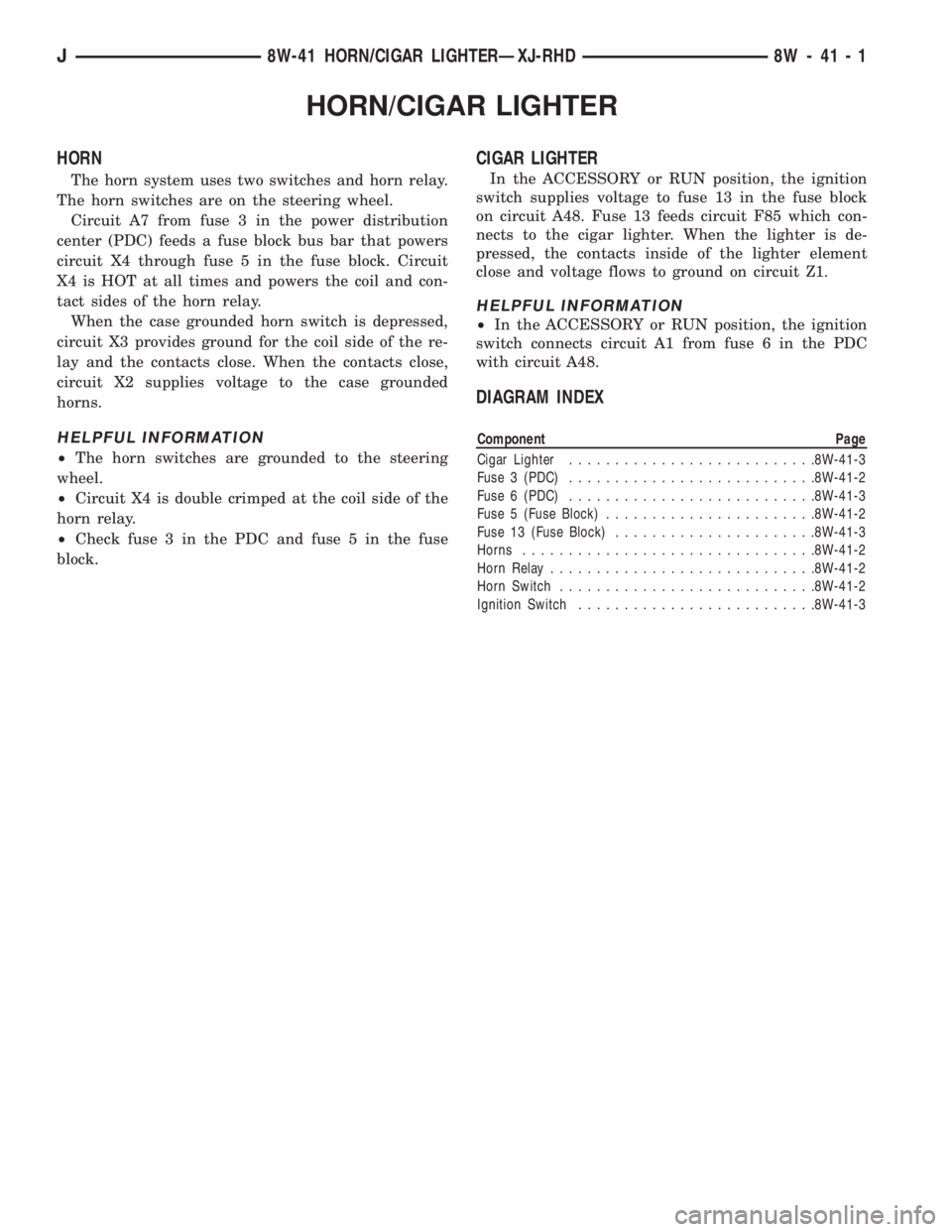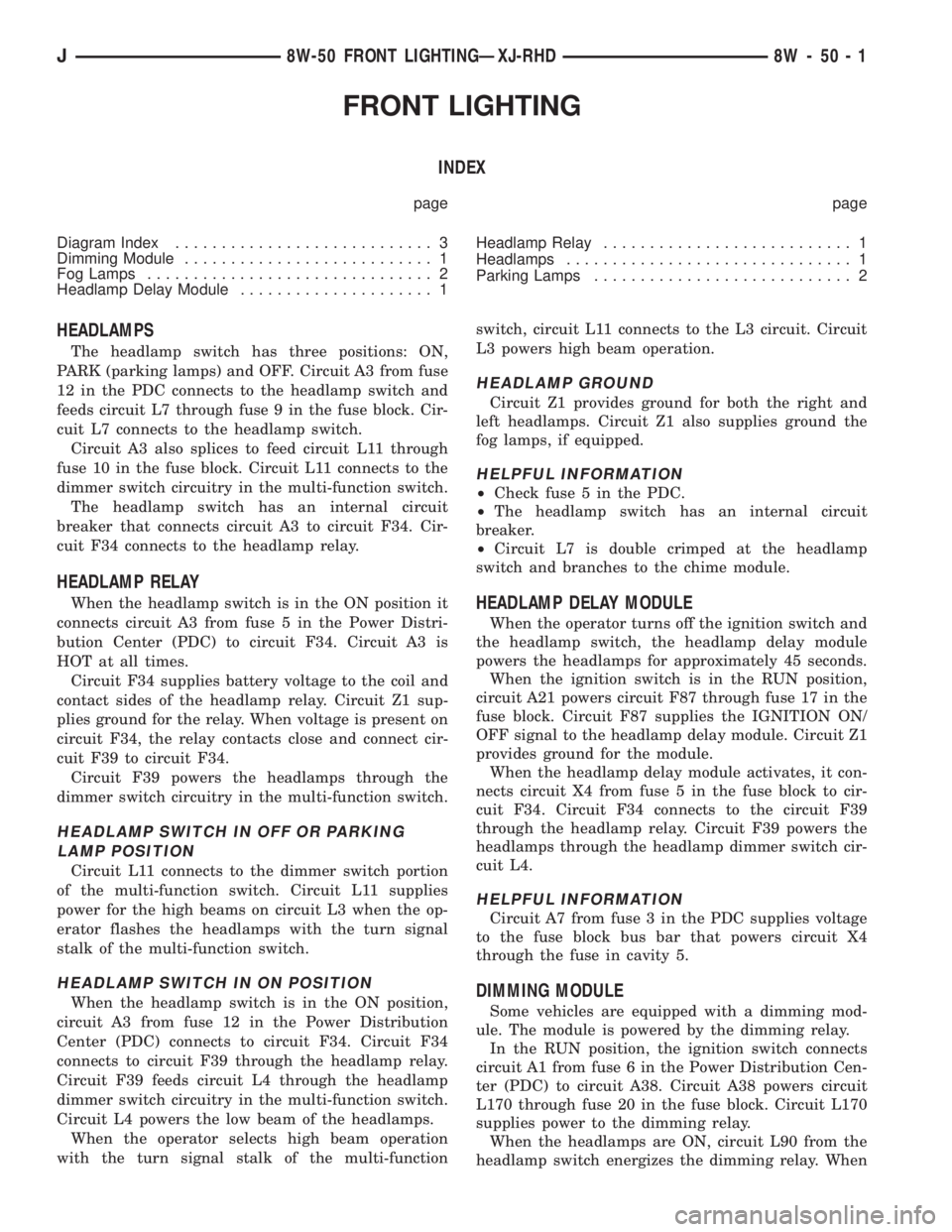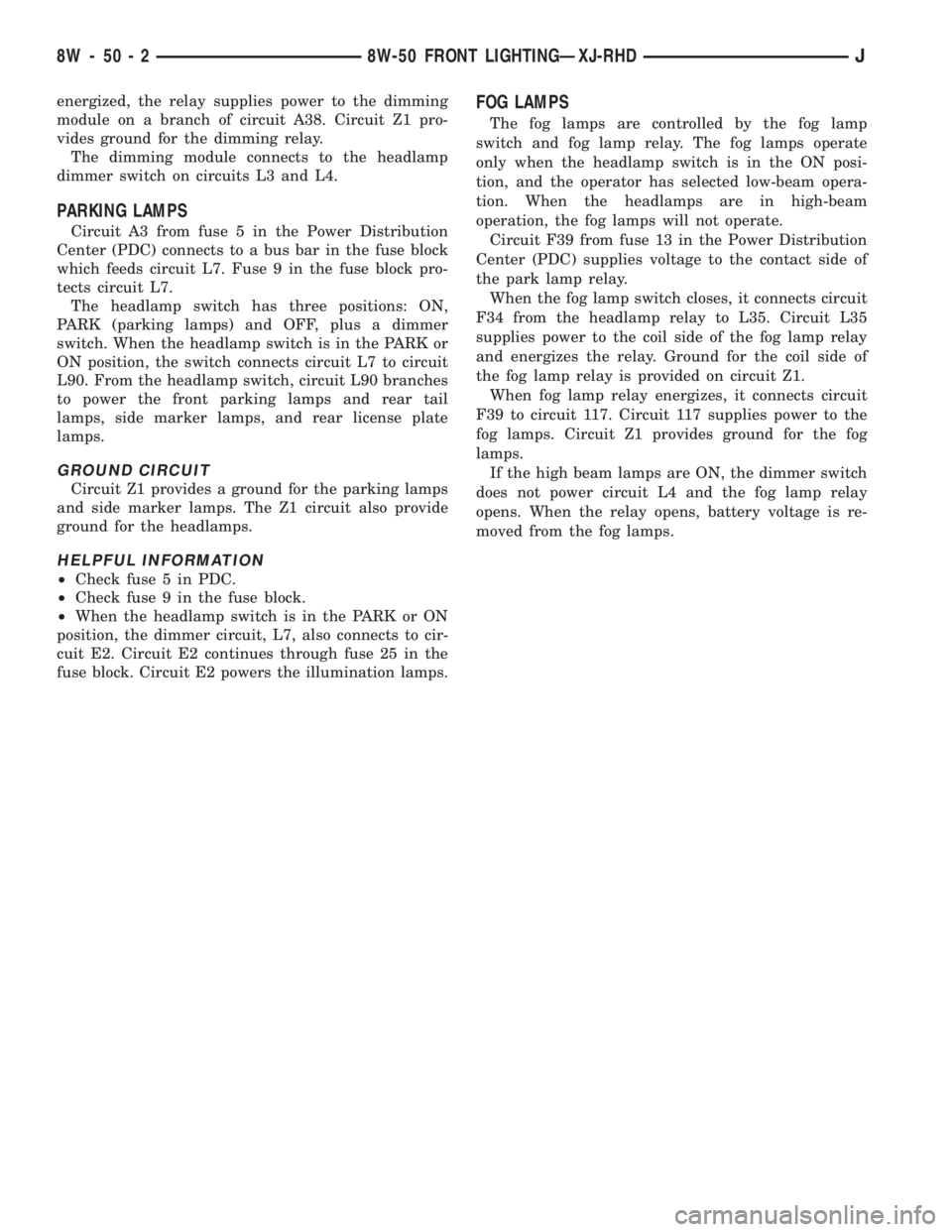1995 JEEP YJ light
[x] Cancel search: lightPage 685 of 2158

WIPERS
INDEX
page page
Diagram Index............................ 2
Rear Wiper System......................... 1WipersÐIntermittent........................ 1
WipersÐStandard.......................... 1
WIPERSÐSTANDARD
A circuit breaker powers the standard wiper sys-
tem. The standard wiper system operates at either
LOW or HIGH speeds.
In the ACCESSORY or RUN position, the ignition
switch connects circuit A1 from fuse 6 in the Power
Distribution Center (PDC) with circuit A48. Circuit
A48 supplies voltage to circuit F86 through the circuit
breaker near the left kick panel.
Circuit F86 is double crimped at the circuit breaker
and supplies power to the wiper switch and the park
switch in the wiper motor. Circuit Z1 from the wiper
motor provides ground for the wiper motor and
switch.
When the operator moves the wiper switch to the
LOW position, battery voltage passes through the
switch to circuit V3. Circuit V3 feeds the wiper motor
low speed brushes. If the operator selects wiper
HIGH speed operation, the wiper switch passes cur-
rent to circuit V4. Circuit V4 feeds the wiper motor
high speed brushes.
As the windshield wiper motor turns, the park
switch, internal to the motor, moves from its DOWN
position to the UP position. When the wiper switch is
turned OFF, the V55 circuit prevents the wipers from
stopping in any position but park.
The windshield washer uses a pump motor located
inside the windshield washer fluid reservoir. When
the washer switch is pressed, power is supplied
through the wiper switch to the pump motor on cir-
cuit V10. Circuit Z1 provide ground for the pump
motor.
HELPFUL INFORMATION
Circuit Z1 also provides ground for the rear wiper
washer pump, radiator fan motor and front end light-
ing.
WIPERSÐINTERMITTENT
A circuit breaker powers the standard wiper sys-
tem. The intermittent wiper system operates at either
LOW or HIGH or DELAY speeds.
In the ACCESSORY or RUN position, the ignition
switch connects circuit A1 from fuse 6 in the PDC
with circuit A48. Circuit A48 supplies voltage to cir-
cuit F86 through the circuit breaker near the left kick
panel.Circuit F86 is double crimped at the circuit breaker
and supplies power to the wiper switch and the park
switch in the wiper motor. Circuit Z1 from the wiper
motor provides ground for the wiper motor and
switch.
When the operator moves the wiper switch to the
LOW position, battery voltage passes through the
switch to circuit V3. Circuit V3 feeds the wiper motor
low speed brushes. If the operator selects wiper
HIGH speed operation, the wiper switch passes cur-
rent to circuit V4. Circuit V4 feeds the wiper motor
high speed brushes.
The DELAY portion of the wiper switch contains a
variable resistor. The variable resistor connects to the
intermittent wiper module through the wiper switch
harness. The amount of delay selected by the operator
determines the voltage drop through the resistor and
the voltage level received by the intermittent wiper
module.
After the intermittent wiper control module deter-
mines the amount of delay selected, it cycles the
wipers by periodically energizing circuit V3. Circuit
V3 powers the wiper motor low speed brushes.
As the windshield wiper motor turns, the park
switch, internal to the motor, moves from its DOWN
position to the UP position. When the wiper switch is
turned OFF, the V55 circuit prevents the wipers from
stopping in any position but park.
The windshield washer uses a pump motor located
inside the windshield washer fluid reservoir. When
the washer switch is pressed, power is supplied
through the wiper switch to the pump motor on cir-
cuit V10. Circuit Z1 provides ground for the pump
motor.
HELPFUL INFORMATION
Circuit Z1 also provides ground for the rear wiper
washer pump, radiator fan motor and front end light-
ing.
REAR WIPER SYSTEM
In the RUN position, the ignition switch connects
circuit A1 from fuse 6 in the PDC with circuit A38.
Circuit A38 connects to a fuse block bus bar that
powers circuit V15 through the fuse in cavity 1. Cir-
cuit V15 supplies power to the rear wiper switch.
J8W-53 WIPERSÐXJ VEHICLES 8W - 53 - 1
Page 795 of 2158

Fig. 8 Front End Lighting Wiring Connectors
Fig. 9 Instrument Panel Ground
J8W-90 CONNECTOR LOCATIONSÐXJ VEHICLES 8W - 90 - 11
Page 819 of 2158

WIRING DIAGRAMS
CONTENTS
page page
8W-01 GENERAL INFORMATIONÐWIRING
DIAGRAMS...................... 8W-01-1
8W-10 FUSE/FUSE BLOCK........... 8W-10-1
8W-11 POWER DISTRIBUTION........ 8W-11-1
8W-15 GROUND DISTRIBUTION....... 8W-15-1
8W-20 CHARGING SYSTEM.......... 8W-20-1
8W-21 STARTING SYSTEM........... 8W-21-1
8W-30 FUEL/IGNITION.............. 8W-30-1
8W-31 TRANSMISSION CONTROLS.... 8W-31-1
8W-32 ANTI-LOCK BRAKES........... 8W-32-1
8W-33 VEHICLE SPEED CONTROL..... 8W-33-1
8W-40 INSTRUMENT CLUSTER....... 8W-40-1
8W-41 HORN/CIGAR LIGHTER........ 8W-41-1
8W-42 AIR CONDITIONING/HEATER.... 8W-42-1
8W-44 INTERIOR LIGHTING.......... 8W-44-1
8W-47 AUDIO SYSTEM.............. 8W-47-18W-48 HEATED REAR WINDOW....... 8W-48-1
8W-49 OVERHEAD CONSOLE.......... 8W-49-1
8W-50 FRONT LIGHTING............ 8W-50-1
8W-51 REAR LIGHTING............. 8W-51-1
8W-52 TURN SIGNALS.............. 8W-52-1
8W-53 WIPERS.................... 8W-53-1
8W-54 TRAILER TOW................ 8W-54-1
8W-60 POWER WINDOWS............ 8W-60-1
8W-61 POWER DOOR LOCKS......... 8W-61-1
8W-62 POWER MIRRORS............ 8W-62-1
8W-63 POWER SEAT................ 8W-63-1
8W-70 SPLICE INFORMATION........ 8W-70-1
8W-80 CONNECTOR PIN OUTS....... 8W-80-1
8W-90 CONNECTOR LOCATIONS...... 8W-90-1
8W-95 SPLICE LOCATIONS........... 8W-95-1
HOW TO USE THIS GROUP
The purpose of this group is to show the electrical
circuits in a clear, simple fashion and to make trou-
bleshooting easier. Components that work together
are shown together. All electrical components used in
a specific system are shown on one diagram. The feed
for a system is shown at the top of the page. All
wires, connectors, splices, and components are shown
in the flow of current to the bottom of the page. Wir-
ing which is not part of the circuit represented is ref-
erenced to another page/section, where the complete
circuit is shown. In addition, all switches, compo-
nents, and modules are shown in theat rest posi-
tion with the doors closed and the key removed
from the ignition.
If a component is part of several different circuits,
it is shown in the diagram for each. For example, the
headlamp switch is the main part of the exterior
lighting, but it also affects the interior lighting and
the chime warning system.
It is important to realize that no attempt is
made on the diagrams to represent components
and wiring as they appear on the vehicle. For
example, a short piece of wire is treated the
same as a long one. In addition, switches and
other components are shown as simply as pos-
sible, with regard to function only.
The wiring diagram show circuits for all wheel-
bases. If there is a difference in systems or compo-
nents between wheel-bases, an identifier is placed
next to the component.
SECTION IDENTIFICATION
Sections in Group 8W are organized by sub-sys-
tems. The sections contain circuit operation descrip-
tions, helpful information, and system diagrams. The
intention is to organize information by system, con-
sistently from year to year.
CONNECTOR LOCATIONS
Section 8W-90 contains Connector Location illus-
trations. The illustrations contain the connector
number and component identification. Connector Lo-
cation charts in Section 8W-90 reference the illustra-
tion number for components and connectors.
Section 8W-80 shows each connector and the cir-
cuits involved with that connector. The connectors
are identified using the number on the Diagram
pages.
SPLICE LOCATIONS
Splice Location charts in Section 8W-70 show the
entire splice, and provide references to other sections
the splice serves.
Section 8W-95 contains illustrations that show the
general location of the splices in each harness. The
illustrations show the splice by number, and provide
a written location.
JWIRING DIAGRAMSÐXJ-RHD 8W - 1 - 1
Page 903 of 2158

HORN/CIGAR LIGHTER
HORN
The horn system uses two switches and horn relay.
The horn switches are on the steering wheel.
Circuit A7 from fuse 3 in the power distribution
center (PDC) feeds a fuse block bus bar that powers
circuit X4 through fuse 5 in the fuse block. Circuit
X4 is HOT at all times and powers the coil and con-
tact sides of the horn relay.
When the case grounded horn switch is depressed,
circuit X3 provides ground for the coil side of the re-
lay and the contacts close. When the contacts close,
circuit X2 supplies voltage to the case grounded
horns.
HELPFUL INFORMATION
²The horn switches are grounded to the steering
wheel.
²Circuit X4 is double crimped at the coil side of the
horn relay.
²Check fuse 3 in the PDC and fuse 5 in the fuse
block.
CIGAR LIGHTER
In the ACCESSORY or RUN position, the ignition
switch supplies voltage to fuse 13 in the fuse block
on circuit A48. Fuse 13 feeds circuit F85 which con-
nects to the cigar lighter. When the lighter is de-
pressed, the contacts inside of the lighter element
close and voltage flows to ground on circuit Z1.
HELPFUL INFORMATION
²In the ACCESSORY or RUN position, the ignition
switch connects circuit A1 from fuse 6 in the PDC
with circuit A48.
DIAGRAM INDEX
Component Page
Cigar Lighter...........................8W-41-3
Fuse 3 (PDC)...........................8W-41-2
Fuse 6 (PDC)...........................8W-41-3
Fuse 5 (Fuse Block).......................8W-41-2
Fuse 13 (Fuse Block)......................8W-41-3
Horns................................8W-41-2
Horn Relay.............................8W-41-2
Horn Switch............................8W-41-2
Ignition Switch..........................8W-41-3
J8W-41 HORN/CIGAR LIGHTERÐXJ-RHD 8W - 41 - 1
Page 913 of 2158

INTERIOR LIGHTING
INDEX
page page
Cargo Lamp and Dome Lamp................. 1
Chime/Buzzer Module....................... 2
Diagram Index............................ 2
General Information........................ 1
Glove Box Lamp........................... 1Ignition Switch Lamp........................ 1
Instrument Panel Illumination Lamps............ 1
Reading Lamps........................... 1
Underhood Lamp.......................... 1
Visor Vanity Mirror Lamps.................... 1
GENERAL INFORMATION
Circuit M1 supplies power to the glove box lamp,
dome lamp, reading lamps, cargo lamp and vanity
lamps. Circuit M1 is protected by fuse 16 in the
Power Distribution Center (PDC).
Circuit E2 supplies power for the instrument panel
illumination lamps.
INSTRUMENT PANEL ILLUMINATION LAMPS
Circuit E2 from the headlamp switch splices to
supply power to the following illumination lamps:
²Ash receiver lamp
²Cigar lighter lamp
²Transmission range indicator lamp
²Transfer case range indicator lamp
²A/C-Heater switch lamp
²Heated rear window switch lamp
²Rear wiper switch lamp
²Fog lamp switch lamp
Fuse 25 in the fuse block protects circuit E2. Cir-
cuit Z1 provides ground for all of the illumination
lamps except for the cigar lighter lamp. The cigar
lighter lamp is case grounded.
HELPFUL INFORMATION
Circuit E2 also supplies power to the radio, LCD
relay and the illumination lamps in the instrument
cluster.
IGNITION SWITCH LAMP
Circuit M50 supplies voltage to the ignition switch
lamp. Circuit Z1 provides ground for the lamp.
GLOVE BOX LAMP
Circuit M1 from fuse 16 in the Power Distribution
Center (PDC) powers the glove box lamp. A case
grounded switch, in series after the lamp, closes
when the glove box door is opened. The switch com-
pletes a path to ground on circuit Z1.
CARGO LAMP AND DOME LAMP
Circuit M1 from fuse 16 in the Power Distribution
Center (PDC) supplies power to the cargo lamp anddome lamp. The M1 circuit is HOT at all times. The
ground path for the lamp is provided in three differ-
ent ways.
One way is through the door jamb switches. Circuit
M2 connects to the door jamb switches to the dome
lamp and cargo lamp. The switches are connected to
ground circuit Z1. When a door is opened, the
plunger in the switch closes, completing a path to
ground.
The second way is through the liftgate switch. Cir-
cuit G71 connects to circuit M2 at the cargo lamp
connector. Circuit G71 connects to the liftgate switch.
The liftgate switch connects to ground circuit Z1.
When the lift gate opens, the plunger in the switch
closes, completing a path to ground.
The third ground path is through the headlamp
switch. Circuit M2 is spliced in with the headlamp
switch. When the operator turns the headlamp
switch to the dome lamp ON position, a ground path
is provided through the switch.
READING LAMPS
Circuit M1 from fuse 16 in the Power Distribution
Center (PDC) supplies power to the reading lamps.
Circuit M1 is HOT at all times. When the operator
depresses the reading lamp, the reading lamp switch
closes and supplies ground on circuit Z1.
VISOR VANITY MIRROR LAMPS
Circuit M1 from fuse 16 in the Power Distribution
Center (PDC) supplies power to the vanity lamps.
Circuit M1 is HOT at all times. When the vanity
lamps switch closes, voltage flows to vanity mirror
lamps. The vanity mirror is case grounded.
UNDERHOOD LAMP
Circuit A7 from fuse 16 in the Power Distribution
Center (PDC) supplies battery voltage for the under-
hood lamp. A mercury switch, in series after the
lamp, connects the lamp to ground on circuit Z1.
When the hood is raised, mercury inside the switch
moves to a position where it connects circuit M1 to
ground circuit Z1, illuminating the lamp.
J8W-44 INTERIOR LIGHTINGÐXJ-RHD 8W - 44 - 1
Page 914 of 2158

CHIME/BUZZER MODULE
The buzzer or optional chime module sounds an au-
dible warning tone. The tone sounds for seat belt
warning and when the ignition key is in the ignition
switch while the drivers door is open. The tone also
sounds when the ignition key is in the ON position
while the drivers side seat belt is not buckled. Lastly,
the tone sounds when the headlamps are ON when
the ignition is OFF. Refer to Group 8U for system op-
eration.
When the ignition switch is in the RUN or START
position, fuse F87 from fuse 26 in the fuse block sup-
plies power to the chime/buzzer module. Circuit A21
from the ignition switch supplies power to fuse 26.
Circuit L7 from fuse 9 in the fuse block also sup-
plies power to the chime/buzzer module. Circuit A3
from fuse 5 in the Power Distribution Center (PDC)
powers fuse 9.
When the parking lamps or headlamps are ON, the
headlamp switch connects circuit G26 with the driv-
ers side door jamb switch. Circuit G26 also connects
to the key-in switch. Circuit M11 connects the key-in
switch to the chime module and the headlamp
switch.
If the headlamps are ON, and the drivers door
opens, ground for the chime/buzzer is on circuit C26
from the headlamp switch through the door jamb
switch to circuit Z1.
If the headlamps are OFF with the key in the ig-
nition while the drivers side door is open, ground for
the chime/buzzer is supplied through the key-in
switch. The ground path is over circuit M11, through
the closed key-in switch to circuit C26. From circuit
C26, the ground path continues through the drivers
door jamb switch to circuit Z1.
Circuit G11 from the buzzer powers the seat belt
warning lamp in the instrument cluster. Circuit Z1
at the instrument cluster provides ground for the
lamp.Circuit G10 from the buzzer connects to the seat
belt switch. When the seat belt switch closes a path
to ground is completed on circuit Z1 and the tone
sounds momentarily.
Circuit Z1 also grounds the chime buzzer module.
HELPFUL INFORMATION
Circuit F87 also powers the instrument cluster and
the headlamp delay module.
DIAGRAM INDEX
Component Page
Cargo Lamp............................8W-44-6
Chime/Buzzer Module......................8W-44-3
Courtesy Lamps.........................8W-44-5
Dome Lamp............................8W-44-6
Door Jamb Switches......................8W-44-7
Fuse 3 (PDC)...........................8W-44-6
Fuse 5 (PDC).........................8W-44-5, 8
Fuse 6 (PDC)...........................8W-44-6
Fuse 9 (Fuse Block).....................8W-44-3, 8
Fuse 16 (PDC)........................8W-44-4, 6
Fuse 25 (Fuse Block)......................8W-44-8
Fuse 26 (Fuse Block)......................8W-44-3
Glove Box Lamp and Switch.................8W-44-5
Headlamp Switch....................8W-44-3, thru 8
Headlamp Delay Module....................8W-44-3
Ignition Switch..........................8W-44-3
Instrument Cluster......................8W-44-3, 9
Instrument Panel Illumination Lamps..........8W-44-8, 9
Key-In Switch...........................8W-44-4
Liftgate Switch..........................8W-44-6
Reading Lamps..........................8W-44-6
Seat Belt Switch.........................8W-44-3
Telltale Connector (Instrument Cluster)...........8W-44-3
Time Delay Relay........................8W-44-4
Underhood Lamp.........................8W-44-4
8W - 44 - 2 8W-44 INTERIOR LIGHTINGÐXJ-RHDJ
Page 939 of 2158

FRONT LIGHTING
INDEX
page page
Diagram Index............................ 3
Dimming Module........................... 1
Fog Lamps............................... 2
Headlamp Delay Module..................... 1Headlamp Relay........................... 1
Headlamps............................... 1
Parking Lamps............................ 2
HEADLAMPS
The headlamp switch has three positions: ON,
PARK (parking lamps) and OFF. Circuit A3 from fuse
12 in the PDC connects to the headlamp switch and
feeds circuit L7 through fuse 9 in the fuse block. Cir-
cuit L7 connects to the headlamp switch.
Circuit A3 also splices to feed circuit L11 through
fuse 10 in the fuse block. Circuit L11 connects to the
dimmer switch circuitry in the multi-function switch.
The headlamp switch has an internal circuit
breaker that connects circuit A3 to circuit F34. Cir-
cuit F34 connects to the headlamp relay.
HEADLAMP RELAY
When the headlamp switch is in the ON position it
connects circuit A3 from fuse 5 in the Power Distri-
bution Center (PDC) to circuit F34. Circuit A3 is
HOT at all times.
Circuit F34 supplies battery voltage to the coil and
contact sides of the headlamp relay. Circuit Z1 sup-
plies ground for the relay. When voltage is present on
circuit F34, the relay contacts close and connect cir-
cuit F39 to circuit F34.
Circuit F39 powers the headlamps through the
dimmer switch circuitry in the multi-function switch.
HEADLAMP SWITCH IN OFF OR PARKING
LAMP POSITION
Circuit L11 connects to the dimmer switch portion
of the multi-function switch. Circuit L11 supplies
power for the high beams on circuit L3 when the op-
erator flashes the headlamps with the turn signal
stalk of the multi-function switch.
HEADLAMP SWITCH IN ON POSITION
When the headlamp switch is in the ON position,
circuit A3 from fuse 12 in the Power Distribution
Center (PDC) connects to circuit F34. Circuit F34
connects to circuit F39 through the headlamp relay.
Circuit F39 feeds circuit L4 through the headlamp
dimmer switch circuitry in the multi-function switch.
Circuit L4 powers the low beam of the headlamps.
When the operator selects high beam operation
with the turn signal stalk of the multi-functionswitch, circuit L11 connects to the L3 circuit. Circuit
L3 powers high beam operation.
HEADLAMP GROUND
Circuit Z1 provides ground for both the right and
left headlamps. Circuit Z1 also supplies ground the
fog lamps, if equipped.
HELPFUL INFORMATION
²Check fuse 5 in the PDC.
²The headlamp switch has an internal circuit
breaker.
²Circuit L7 is double crimped at the headlamp
switch and branches to the chime module.
HEADLAMP DELAY MODULE
When the operator turns off the ignition switch and
the headlamp switch, the headlamp delay module
powers the headlamps for approximately 45 seconds.
When the ignition switch is in the RUN position,
circuit A21 powers circuit F87 through fuse 17 in the
fuse block. Circuit F87 supplies the IGNITION ON/
OFF signal to the headlamp delay module. Circuit Z1
provides ground for the module.
When the headlamp delay module activates, it con-
nects circuit X4 from fuse 5 in the fuse block to cir-
cuit F34. Circuit F34 connects to the circuit F39
through the headlamp relay. Circuit F39 powers the
headlamps through the headlamp dimmer switch cir-
cuit L4.
HELPFUL INFORMATION
Circuit A7 from fuse 3 in the PDC supplies voltage
to the fuse block bus bar that powers circuit X4
through the fuse in cavity 5.
DIMMING MODULE
Some vehicles are equipped with a dimming mod-
ule. The module is powered by the dimming relay.
In the RUN position, the ignition switch connects
circuit A1 from fuse 6 in the Power Distribution Cen-
ter (PDC) to circuit A38. Circuit A38 powers circuit
L170 through fuse 20 in the fuse block. Circuit L170
supplies power to the dimming relay.
When the headlamps are ON, circuit L90 from the
headlamp switch energizes the dimming relay. When
J8W-50 FRONT LIGHTINGÐXJ-RHD 8W - 50 - 1
Page 940 of 2158

energized, the relay supplies power to the dimming
module on a branch of circuit A38. Circuit Z1 pro-
vides ground for the dimming relay.
The dimming module connects to the headlamp
dimmer switch on circuits L3 and L4.
PARKING LAMPS
Circuit A3 from fuse 5 in the Power Distribution
Center (PDC) connects to a bus bar in the fuse block
which feeds circuit L7. Fuse 9 in the fuse block pro-
tects circuit L7.
The headlamp switch has three positions: ON,
PARK (parking lamps) and OFF, plus a dimmer
switch. When the headlamp switch is in the PARK or
ON position, the switch connects circuit L7 to circuit
L90. From the headlamp switch, circuit L90 branches
to power the front parking lamps and rear tail
lamps, side marker lamps, and rear license plate
lamps.
GROUND CIRCUIT
Circuit Z1 provides a ground for the parking lamps
and side marker lamps. The Z1 circuit also provide
ground for the headlamps.
HELPFUL INFORMATION
²Check fuse 5 in PDC.
²Check fuse 9 in the fuse block.
²When the headlamp switch is in the PARK or ON
position, the dimmer circuit, L7, also connects to cir-
cuit E2. Circuit E2 continues through fuse 25 in the
fuse block. Circuit E2 powers the illumination lamps.
FOG LAMPS
The fog lamps are controlled by the fog lamp
switch and fog lamp relay. The fog lamps operate
only when the headlamp switch is in the ON posi-
tion, and the operator has selected low-beam opera-
tion. When the headlamps are in high-beam
operation, the fog lamps will not operate.
Circuit F39 from fuse 13 in the Power Distribution
Center (PDC) supplies voltage to the contact side of
the park lamp relay.
When the fog lamp switch closes, it connects circuit
F34 from the headlamp relay to L35. Circuit L35
supplies power to the coil side of the fog lamp relay
and energizes the relay. Ground for the coil side of
the fog lamp relay is provided on circuit Z1.
When fog lamp relay energizes, it connects circuit
F39 to circuit 117. Circuit 117 supplies power to the
fog lamps. Circuit Z1 provides ground for the fog
lamps.
If the high beam lamps are ON, the dimmer switch
does not power circuit L4 and the fog lamp relay
opens. When the relay opens, battery voltage is re-
moved from the fog lamps.
8W - 50 - 2 8W-50 FRONT LIGHTINGÐXJ-RHDJ